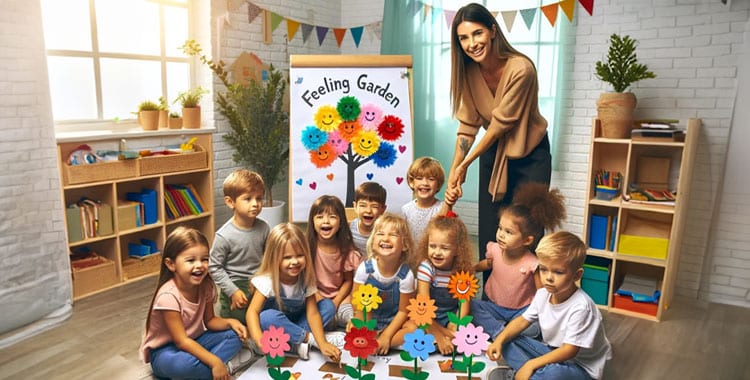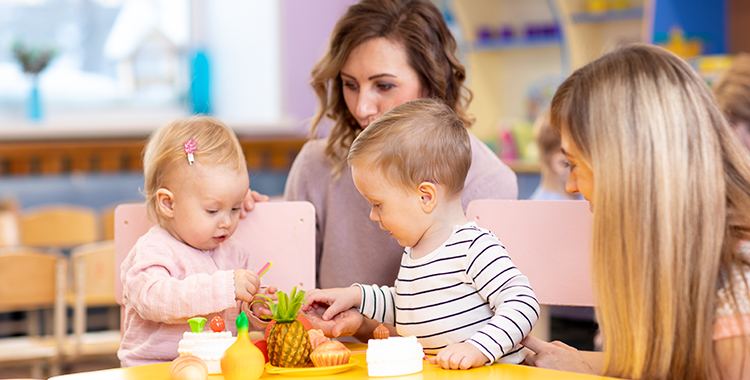Growing Hearts and Minds: How Educators Can Help Kids Understand Their Feelings
In the world of looking after and teaching young kids, there’s something just as crucial as learning ABCs and 123s: emotional intelligence (EI). Emotional intelligence is about helping kids understand and manage their feelings, play well with others, and handle ups and downs. Let’s dive into how teachers and childcare workers can make a big difference in growing not just smart kids, but also kind and strong-hearted ones.
What is Emotional Intelligence?
Think of emotional intelligence as being the boss of your feelings. It’s like having a toolbox to fix problems with how we feel and get along with friends. For little ones, this means learning to say, “I’m mad” instead of throwing toys or “I’m sad” when they need a hug.
Teachers, You’re Up!
As a teacher or someone who looks after kids, you’re like a superhero who teaches them these superpowers. Your mission? Show them how to understand their feelings, play nice, and solve problems without fights or tears.
Let’s Talk About Feelings
First, make your classroom a place where talking about feelings is okay. You can start the day by asking everyone how they feel and why. It’s like a morning hello but with feelings. This helps kids learn words for their emotions and shows them it’s okay to share.
Cool Down Tricks
Sometimes, feelings can get too big, like a balloon ready to pop! Teach kids simple tricks to cool down. Taking deep breaths, counting to ten, or using words to say what’s wrong can turn a big, scary feeling into something much smaller and easier to handle.
Walking in Someone Else’s Shoes
Being able to understand how others feel is like magic. It helps us get along better. Try fun activities where kids pretend to be each other or tell stories about how different characters might feel. This teaches them to be good friends who care about others’ feelings.
Making Friends and Talking it Out
A happy classroom is one where everyone feels like friends. Encourage kids to talk to each other, listen, and respect differences. Simple games requiring teamwork or sharing stories can make everyone feel included and valued.
It’s a Journey
Learning about emotions isn’t something that happens overnight. It’s a journey that keeps going, just like learning to read or ride a bike. Keep trying new things, talking about feelings, and being a great role model. Your work makes a big difference in kids’ lives, helping them grow to be kind, understanding, and strong in facing life’s ups and downs.
Wrapping It Up
Teaching kids about emotional intelligence is like planting seeds for a garden of kind, smart, and strong people. By helping them understand their feelings and get along with others, you’re setting them up for a great future. Let’s make every day a chance to grow hearts and minds together. After all, kindness and understanding can make the world a better place for everyone.
Lesson Plan: “The Feeling Garden” – Incorporating Emotional Intelligence into the Classroom
Objective
Children will learn to identify and express their feelings and recognise those feelings in others, fostering emotional intelligence through a creative and interactive activity.
Age Group
4-6 years old
Materials Needed:
- Construction paper (various colours)
- Markers or crayons
- Popsicle sticks
- Glue
- A large poster board (for the garden)
- Pictures of faces showing different emotions (happy, sad, angry, surprised, scared, etc.)
Duration
30-45 minutes
Activity Outline
Introduction (5-10 minutes)
- Start with a circle time discussion about feelings. Ask questions like, “How do you feel today?” and “What makes you feel happy/sad/angry?”
- Introduce the concept of a “Feeling Garden” where each flower represents a different emotion.
Emotion Exploration (10-15 minutes)
- Show the pictures of faces expressing different emotions. Discuss each emotion, asking children to describe times they have felt that way.
- Encourage children to share how they can tell someone else feels that way, emphasising facial expressions and body language.
Creating the Feeling Garden (15-20 minutes)
- Give each child a set of materials to create their own “emotion flower.” Each flower should represent a different emotion, using colours and shapes to express the feeling. For example, a happy flower might be bright yellow with a big smile drawn on it.
- Help children glue their flowers onto popsicle sticks.
Planting the Feeling Garden (5-10 minutes)
- On the large poster board, create areas for each type of emotion (a happy area, a sad area, etc.). This will be the communal “Feeling Garden.”
- Invite children to “plant” their emotional flowers in the appropriate garden area. Encourage them to share when they felt that emotion as they placed their flower.
Reflection and Discussion (5 minutes)
- Gather the children and reflect on the Feeling Garden. Discuss the various emotions and how feeling all of them is okay.
- Emphasise that, like in a garden, where every flower is different yet beautiful, every feeling has its place and importance.
Follow-Up
Leave the Feeling Garden displayed in the classroom. Refer back to it during other discussions about feelings or when resolving conflicts.
Encourage children to add new emotional flowers to the garden as they explore more feelings.
Learning Outcomes
- Children will understand that it’s natural to experience a range of emotions.
- They will improve their ability to express their own emotions and recognise those emotions in others.
- This activity fosters empathy by sharing and listening to each other’s emotional experiences.
This simple, hands-on lesson plan not only teaches emotional intelligence but also provides a visual and interactive way for children to explore and express their feelings, laying the foundation for empathy and emotional awareness in early childhood.

Hannah
Marketing Manager




